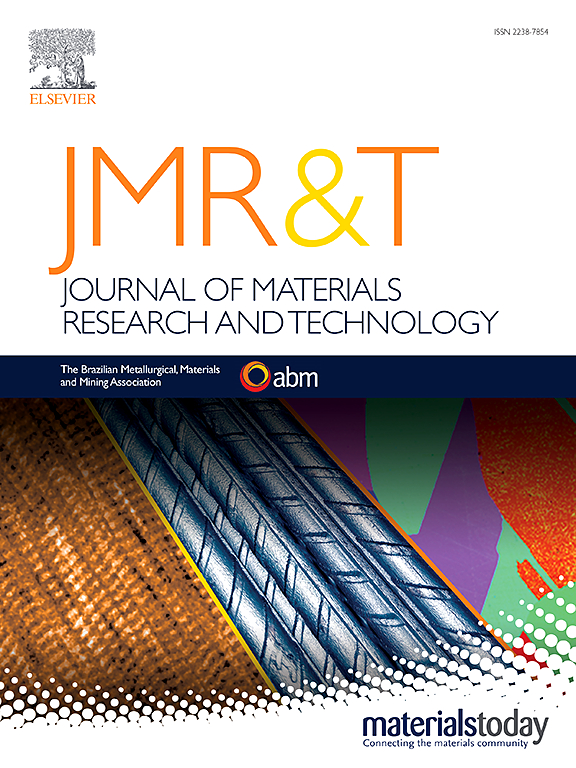Synergistic enhancement of mechanical and tribological properties in WC-reinforced 316L stainless steel matrix composite fabricated by laser powder bed fusion
IF 6.6
2区 材料科学
Q1 MATERIALS SCIENCE, MULTIDISCIPLINARY
Journal of Materials Research and Technology-Jmr&t
Pub Date : 2025-06-09
DOI:10.1016/j.jmrt.2025.06.046
引用次数: 0
Abstract
Austenitic 316L stainless steel, renowned for its excellent toughness and corrosion resistance, is widely used in aerospace, precision molds, and automotive industries. However, its limited strength at both room and high temperatures, coupled with poor tribological properties, restricts broader applications. To address these limitations, this study has fabricated a novel stainless steel matrix composite, 3 %WC/316L, with excellent strength-toughness, heat-resistance, and tribological properties, leveraging the inherent advantages of laser powder bed fusion technology through synergistic strengthening mechanisms: fine grain strengthening, particle reinforcement, and precipitation hardening. Following aging treatment at 800 °C for 2 h, the composite comprises a columnar grain structure with uniformly dispersed partially-melted spherical WC particles (∼1 vol%). A well-bonded diffusion zone with a width of 1∼2 μm forms between the unmelted WC cores and the matrix. Crucially, abundant submicron-scale M23C6 carbides (100–400 nm) precipitate along grain boundaries and within the columnar grains adjacent to the particles. The composite demonstrates superior mechanical properties: at room temperature, the ultimate tensile strength (UTS), yield strength (YS), elongation to fracture (EL), and impact toughness (αkv) can reach 802 MPa, 554 MPa, 30.5 %, and 55.5 J/cm2, respectively; at 400 °C, UTS, YS, and EL still remain at 616 MPa, 370 MPa, and 20.8 %, respectively. Furthermore, the tribological properties are significantly enhanced: at room-temperature, hardness reaches 18.9 HRC, with the average coefficient of friction (COF) and volumetric wear rate (Wr) reduced to 0.6212 and 50.3 × 10−6 mm3/(N·m), respectively; at 400 °C, COF and Wr further decrease to 0.5291 and 43.6 × 10−6 mm3/(N·m), respectively.
激光粉末床熔合制备wc增强316L不锈钢基复合材料的力学和摩擦学性能
奥氏体316L不锈钢以其优异的韧性和耐腐蚀性而闻名,广泛应用于航空航天、精密模具和汽车行业。然而,其在室温和高温下的强度有限,加上较差的摩擦学性能,限制了其更广泛的应用。为了解决这些限制,本研究利用激光粉末床熔融技术的固有优势,通过细晶强化、颗粒强化和沉淀硬化机制,制备了一种新型的不锈钢基复合材料,3% WC/316L,具有优异的强度-韧性、耐热性和摩擦学性能。在800℃时效处理2 h后,复合材料包括柱状晶粒结构,其中均匀分散的部分熔化的球形WC颗粒(约1 vol%)。在未熔化的WC芯和基体之间形成了一个宽度为1 ~ 2 μm的良好结合扩散区。重要的是,大量亚微米尺度的M23C6碳化物(100-400 nm)沿晶界和邻近颗粒的柱状晶粒内析出。该复合材料表现出优异的力学性能:室温下,极限抗拉强度(UTS)、屈服强度(YS)、断裂伸长率(EL)和冲击韧性(αkv)分别达到802 MPa、554 MPa、30.5%和55.5 J/cm2;在400℃时,UTS、YS和EL分别保持在616 MPa、370 MPa和20.8%。摩擦性能显著提高:室温下硬度达到18.9 HRC,平均摩擦系数(COF)和体积磨损率(Wr)分别降至0.6212和50.3 × 10−6 mm3/(N·m);在400℃时,COF和Wr分别降至0.5291和43.6 × 10−6 mm3/(N·m)。
本文章由计算机程序翻译,如有差异,请以英文原文为准。
求助全文
约1分钟内获得全文
求助全文
来源期刊

Journal of Materials Research and Technology-Jmr&t
Materials Science-Metals and Alloys
CiteScore
8.80
自引率
9.40%
发文量
1877
审稿时长
35 days
期刊介绍:
The Journal of Materials Research and Technology is a publication of ABM - Brazilian Metallurgical, Materials and Mining Association - and publishes four issues per year also with a free version online (www.jmrt.com.br). The journal provides an international medium for the publication of theoretical and experimental studies related to Metallurgy, Materials and Minerals research and technology. Appropriate submissions to the Journal of Materials Research and Technology should include scientific and/or engineering factors which affect processes and products in the Metallurgy, Materials and Mining areas.
 求助内容:
求助内容: 应助结果提醒方式:
应助结果提醒方式:


